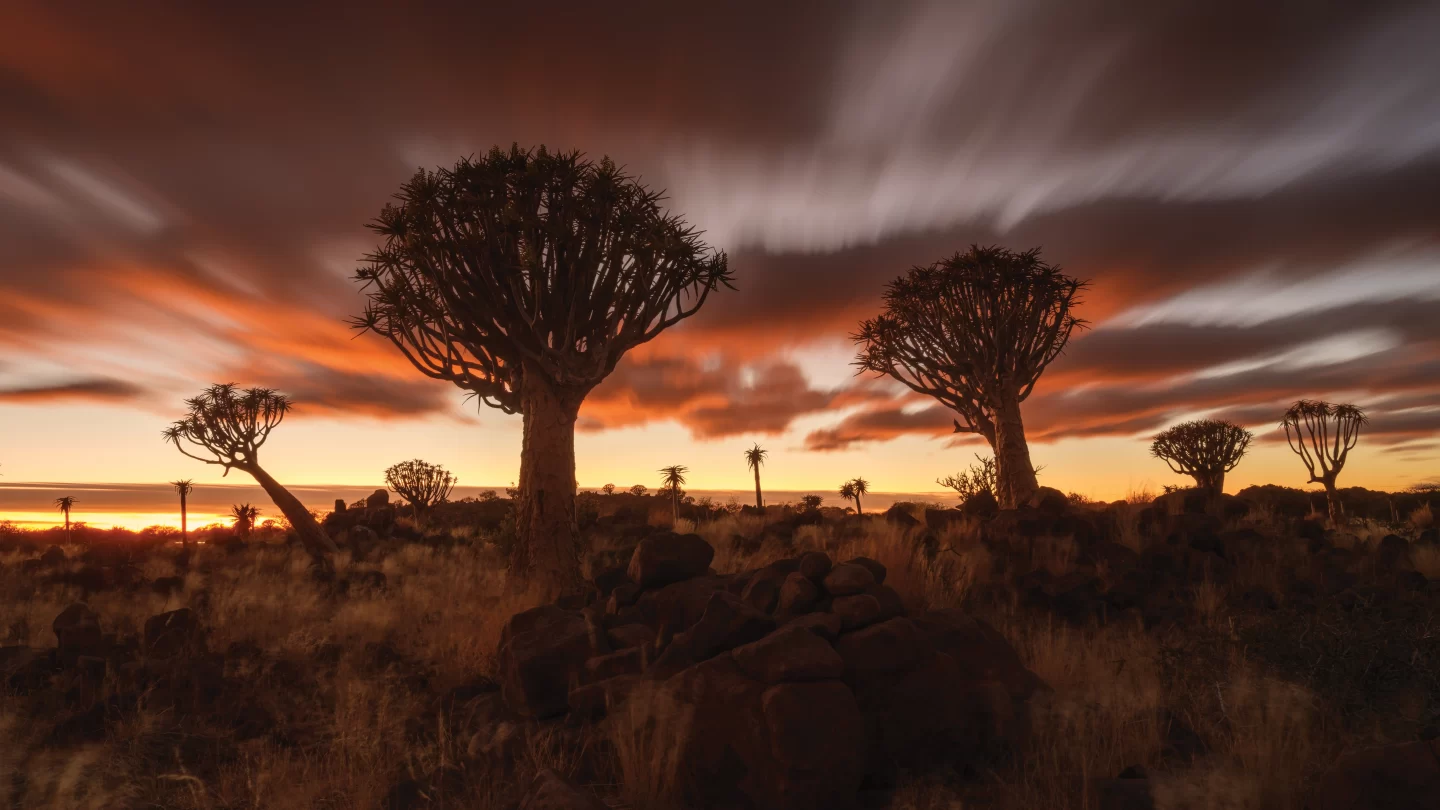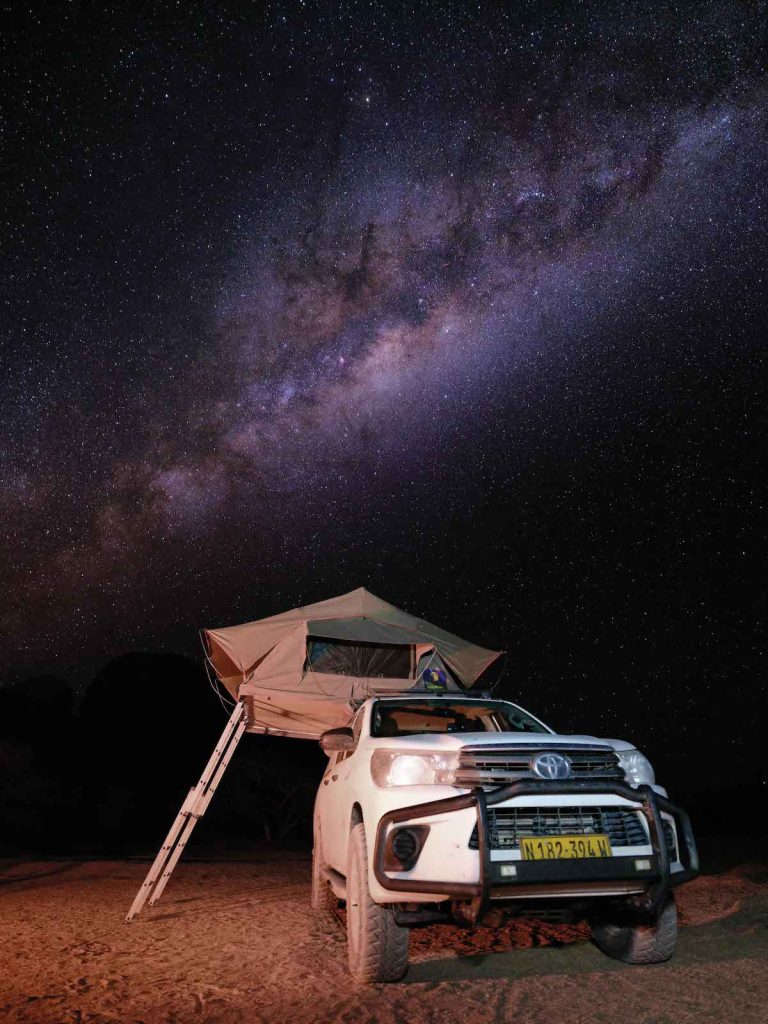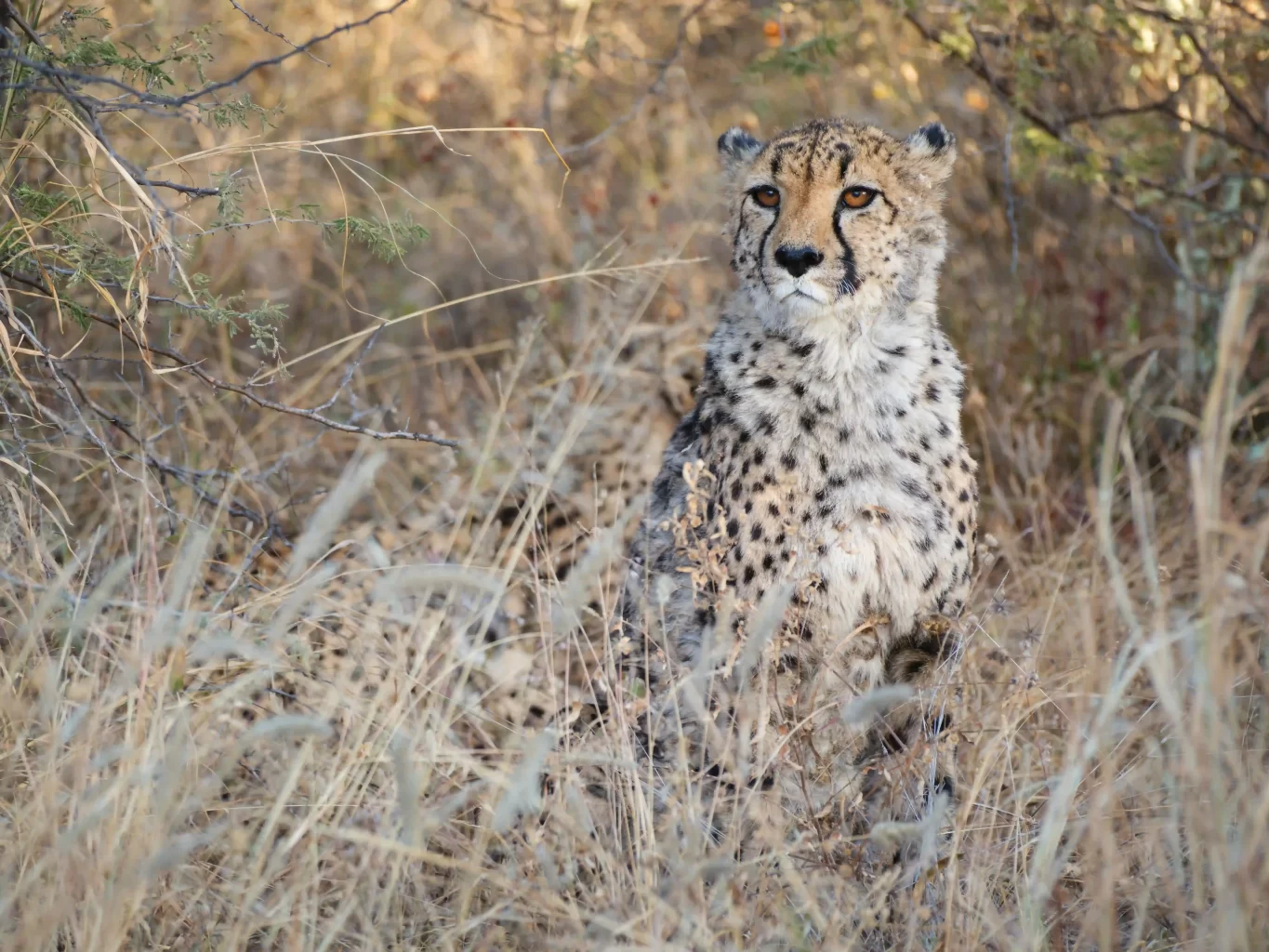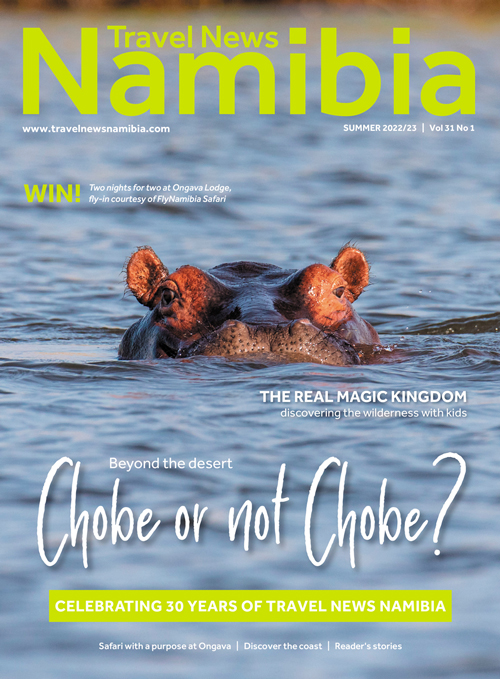

THE JOURNEY OF A LIFETIME – a Reader’s Story
Text & Photographs –Harmen Piekema
the Summer 2022/23 issue
This is the story of our journey through Namibia. With our 4-year-old daughter and a friend, who was 31 weeks pregnant, we ventured into the unknown. Exploring the country with a map, some guidebooks and a Toyota Hilux with a family-size rooftop tent. We were curious and ready for adventure!
Buzzing with excitement, we are waiting at Asco to meet our companion for the trip: a Toyota Hilux pick-up with a rooftop tent. As the car rolls in, we smile: “It is finally happening!”.
After a thorough introduction we are ready to hit the road. Our first destination: Quivertree Forest. At first I am somewhat nervous about driving on the left side, but luckily this fades after a while. The road is long and straight. Around sunset, we marvel at the colours of the landscape – pastel and gold!
The next morning starts early. Because I am a landscape photographer, I have to wake up before sunrise. The sky looks promising. Lots of clouds but not in the east, where the sun rises. It is still pitchblack when I enter the ‘forest’. I fully enjoy the stillness and take in the dark surroundings. I follow my senses and not before long, I find my first image. Meanwhile the sky starts to turn a dramatic orange colour. I feel really lucky and cannot believe my eyes!
The landscape is so pretty and I feel blessed to be here.
We stay at this place for two days, hiking, photographing and enjoying the beautiful scenery of both the Quivertree Forest and the Giant’s Playground, before we continue south towards the Fish River Canyon – the second largest canyon in the world. At Canyon Farmyard (highly recommended) we eat strudel, marvel at the curiosities and continue on our way to the edge of the canyon. The view is spectacular, the landscape immense. And in contrast to Europe, we are alone! There is nobody else around.
Our campsite is at Ai-Ais National Park where we immerse ourselves in the healing hot springs. Revitalized, we follow the Orange River towards the ocean. We are heading to Lüderitz. There is a much faster route, but for part of the way we take this detour along the natural border with South Africa and via Rosh Pinah.
A sign tells us the road is closed, but locals tell us it is not. Therefore we take the gamble and continue on our path. The Orange River is wide, green and beautiful. We come across several troops of baboons.
We are still a bit anxious about the road being closed, but even at a road maintenance site we are allowed to pass. The friendly worker tells us, “The road is not closed, we just make it nice”. Fantastic, we love Africa!
Before we drive into Lüderitz, we spot the famous wild horses from the road. There are quite a few and we call ourselves lucky, because they are rare and often hard to find.
Lüderitz lies tucked in between the ocean and the desert and feels really remote. For a change we stay in a lovely guesthouse because this place can be extremely windy, which is not ideal in a rooftop tent.
We visit the famous Kolmanskuppe of course and take a guided tour, which we highly recommend.
But the peninsula, with its rugged coastline, has so much more to offer.
On our way to Diaz Point, we spot our first flamingos, and follow many of the really fun 4×4 roads to explore the coast. Every turn ends in a gem!
For sunset we pick Kleiner Bogenfels to watch the sun sink into the ocean.
As we leave Lüderitz I feel somewhat nervous. We are going to Sossusvlei, a Mecca for landscape photographers. We follow the D707, a beautiful gravel and sand road through varying landscapes. From the car we spot several groups of gemsbok, zebra and springbok. Amazing!
The next morning we pass the gate into Namib-Naukluft Park. The last 5 km are the most fun: off-road, through loose sand. At the parking lot we meet a friendly jackal scavenging for food. After a short hike we get our first glimpse of Deadvlei and we are blown away! We had seen photos, but that is nothing compared to seeing it for real. The vastness of the landscape is mindblowing. The dead trees are spectacular. They seem to tell a story.
We see people on top of the Big Daddy dune, and of course Joke says we have to go too. She is probably one of very few ladies who have stood on top of that dune at over 31 weeks pregnant. The view is spectacular. The shapes, patterns and colours are amazing. The beauty of this landscape is beyond imagination!

The next day, as we set off to Swakopmund, the weather changes and rain clouds roll in – a rare sight in the desert. In Walvis Bay it rains and our first glimpse of this urban area gives us a culture shock. We have to acclimatise to being in a city after the days spent in nature.
Swakopmund is easy to fall in love with. There is a lot to do, too. We stroll along streets with romantic buildings, take tours and go kayaking with seals. There is so much to do, we could easily spend weeks here, but we have to continue our journey.
While driving into the campsite at Spitzkoppe, one cannot help but feel small. The landscape is incredibly picturesque and rough. This is where we will camp. Fantastic!
Because we are so far from light pollution, the night seems particularly dark and the Milky Way bright. With a nice fire, some food and a drink we watch the many stars in awe.
We continue to Etosha where we have an incredible encounter with a huge elephant bull on our first day. Out of nowhere, he walks straight to a waterhole and starts to drink.
There are a lot of other animals, but all of a sudden they all back off. In the rearview mirror I see a lioness walking towards the waterhole, her face still covered in blood from the kill made during the night.
We cannot believe our eyes. Now we really know we are in Africa!! All these animals, which we only know from documentaries, are right in front of us. During our time in Etosha we have many more incredible encounters with elephants, rhinos, zebras and lots of other animals.
So many, I could write a whole story on Etosha alone.
So many cool animals and we still want more! Therefore, we visit Okonjima Nature Reserve. Again, we find ourselves at a beautiful campsite. During the night we spot two genet cats and five zebras grazing next to the tent.
The next day, we take a guided tour at the Africat Foundation. We learn a lot about conservation in Namibia, and Africa in general. And to top it off, our guide takes us to the cheetahs. The low sunlight makes it hard to see them, but also makes for fantastic photographic opportunities. When we finally find a female, we are struck by her beauty.
With the final two days spent at the Waterberg Plateau National Park, our journey is coming to an end. On our hike to the top of the plateau we are surprised by the number of trees growing on the slopes of the mountain. Some parts even remind us of a jungle. We spot numerous birds, butterflies, baboons and klipdassies. A perfect way to end our journey.
Namibia is made for camping, and we cannot think of a better way to explore the country. Driving on the many gravel roads is fun and most of them are in a really good condition. The people we met were very friendly and made us feel welcome. Three weeks is way too short to see the whole of Namibia, but our trip made us feel eager to return and see more of this beautiful country.

Share your Namibian adventure with us by sending your Reader’s Story to [email protected].
Read full issue online
Lorem ipsum dolor sit amet, consectetur adipiscing elit. Ut elit tellus, luctus nec ullamcorper mattis, pulvinar dapibus leo.





